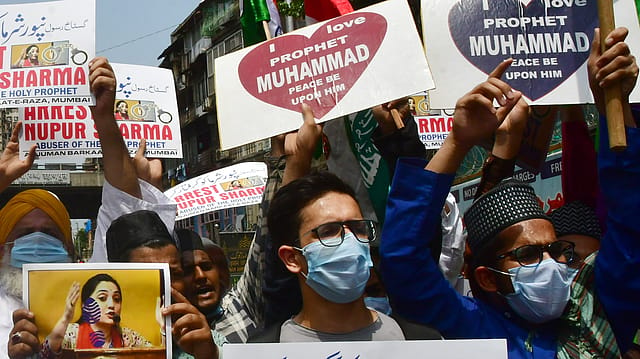Why India cannot afford to lose GCC over hate speech
ADVERTISEMENT

The suspension of two BJP spokespersons for making derogatory remarks against Prophet Muhammad and Muslim community seems to be not just a face saving exercise for the ruling party, but also a necessity.
The economic and commercial interests India has with the West Asian countries that are aggrieved by the remarks are significant. The Gulf Cooperation Council (GCC), which most of these countries are part of, is a region with which India is striving to sign a comprehensive free trade agreement for two way investment flows. It provides jobs to more than half of non-resident Indians (NRIs); it accounts for almost half of the total remittances flow into the country.
The countries that expressed concerns against BJP leaders' remarks include Saudi Arabia, Qatar, Kuwait, Bahrain and the Organisation of Islamic Cooperation (OIC) - the 57 member country group which includes the entire Gulf region and other parts of Asia, Africa and Europe. Though, the GCC - which comprises Saudi Arabia, the UAE, Kuwait, Qatar, Bahrain and Oman - is the key in terms of India's strategic economic and commercial relationship.
According to the Ministry of External Affairs, "India's old, historical ties with GCC States, coupled with increasing imports of oil and gas, growing trade and investment, and presence of approximately 6.5 million Indian workers in the region, are of vital interest to India." The ministry also notes that India's economic linkage with the GCC have increased steadily, especially due to growth in oil imports. During 2020-21, India's exports to GCC were $28.06 billion. The bilateral two-way trade during the period was $87.36 billion, it states.
December 2025
The annual Fortune 500 India list, the definitive compendium of corporate performance, is out. This year, the cumulative revenue of the Fortune 500 India companies has breached $2 trillion for the first time. Plus, find out which are the Best B-schools in India.
In fact, of the 13 million non resident Indians (NRIs), 3.4 million live in the UAE. Saudi Arabia accounts for another 2.6 million, Kuwait, Oman, Qatar and Bahrain adding another 2 million, making it the biggest region for Indians outside India. Any hostile approach adopted towards this working population by GCC members can create a humanitarian crisis in India. A study on India's inward remittances by the Reserve Bank of India in 2018 had shown that 82% of the total remittances received by India originated from seven countries, viz., the United Arab Emirates (UAE), the United States (US), Saudi Arabia, Qatar, Kuwait, the United Kingdom (UK) and Oman. It also indicated that 58.7% of total remittances were received by four states namely Kerala, Maharashtra, Karnataka and Tamil Nadu. The remittance economy is integral to the economic progress of at least some of them. With an inflow of $89 billion in 2021, India was the top recipient of remittance inflow in the world last year.
The Comprehensive Economic Partnership Agreement (CEPA) signed between the Government of the Republic of India and the Government of the United Arab Emirates (UAE) in February 2022 is another indication of the grand plans India have with GCC members. Aimed at boosting the merchandise trade between the two countries to $100 billion over next five years, India-UAE CEPA has several provisions including "digital trade" and "government procurement" that cannot be seen in most other existing bilateral agreements India has signed. For the record, UAE was India's third biggest trade partner in 2021-22. Saudi Arabia and Qatar also figure among the top 25 trade merchandise trade partners of India.
The emerging opportunities for investment in both India and GCC have also generated tremendous interest among large corporates in the region.
Party spokespersons can be dispensed with, but the larger economic and commercial interests are too big to ignore.
